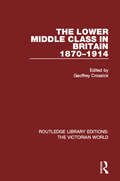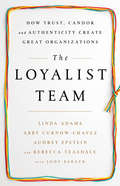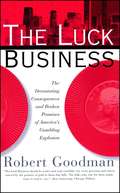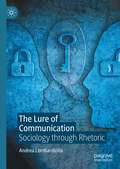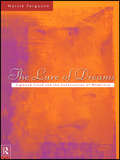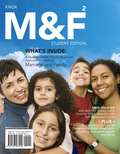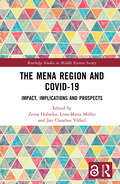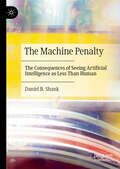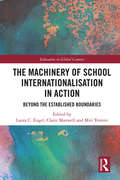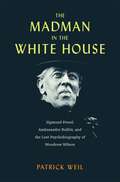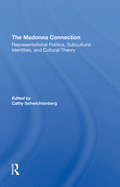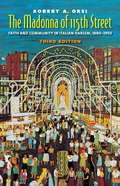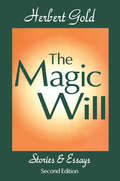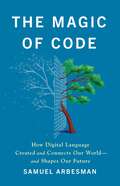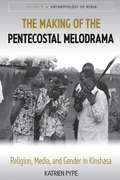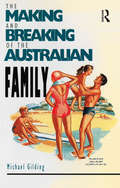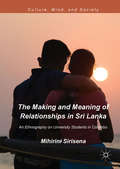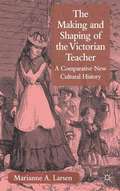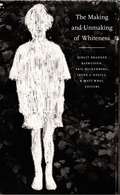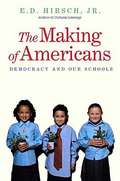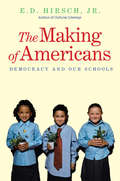- Table View
- List View
The Lower Middle Class in Britain 1870-1914 (Routledge Library Editions: The Victorian World #10)
by Geoffrey CrossickFirst published in 1977. This book records the emergence of a lower middle class in late Victorian and Edwardian Britain. Victorian society had always contained a marginal middle class of shopkeepers and small businessmen, but in the closing decades of the nineteenth century the growth of white-collar salaried occupations created a new and distinctive force in the social structure. These essays look at the place of the lower middle class within British society and examine its ideals and values. Some essays concentrate on occupational groups – clerks and shopkeepers – while others focus on aspects of lower middle class life – religion, housing and jingoism. This title will be of interest to students of history.
The Loyalist Team: How Trust, Candor, And Authenticity Create Great Organizations
by Linda Adams Jody Berger Abby Curnow-Chavez Audrey Epstein Rebecca TeasdaleGreat teams are built and maintained with great intention, though they can make it look deceptively easy. Too many teams engage in dysfunctional behaviors or fall into territorialism, apathy, and unproductive relationships. The result? An overwhelmed, unengaged, and stressed-out workforce that settles for average or poor performance.Here, four authors with a combined century of management experience show readers how every team can be extraordinary. The authors introduce their field-tested Loyalist Team 3D assessment that allows anyone to get to the heart of why teams break down, identify the weaknesses in their own team, and build a Loyalist Team. This kind of team has members who ensure each other's success as they work to ensure their own, operate with absolute candor, and value loyalty and authenticity to deliver results, create a healthy work environment, and help companies succeed. The Loyalist Team is a must-read for anyone who wants their team to achieve extraordinary results.
The Luck Business
by Robert GoodmanIn this damning indictment of legalized gambling, Goodman documents how this business, which generates more than $40 billion dollars a year in revenues, is also the cause of myriad economic and social problems for the very communities that have looked to it as a panacea.
The Lure of Communication: Sociology through Rhetoric
by Andrea LombardiniloThis book addresses the convergence of sociology, communication and rhetoric, with particular reference to the contemporary expressive and social patterns of mass communication. Using rhetoric as a meta-conceptual apparatus for the sociology of communication, this book offers an original and comprehensive critique of historical social theory alongside 20th century communication researchers. The author demonstrates the symbiotic relationship between the rhetorical structures of the media-sphere and the new narrative formats in which cultural representation merges into social and civil observation. This book will be of interest to academics and students studying sociology, communication and cultural studies.
The Lure of Dreams: Sigmund Freud and the Construction of Modernity
by Harvie FergusonFrom literary theory to social anthropology, the influence of Freud runs through every part of the human and social sciences. In The Lure of Dreams, Harvie Ferguson shows how Freud's writings and particulary The Interpretation of Dreams contribute, both in their content and in the baroque and dream-like forms in which they are cast, to our understanding of the character of modernity. This novel and stimulating approach to Freud and to the dilemmas of modernity and postmodernity will fascinate everyone with an interest in the development of the modern consciousness.
The M & F Solution
by The Editors at the Cengage LearningA student textbook about marriage and family.
The MENA Region and COVID-19: Impact, Implications and Prospects (Routledge Studies in Middle Eastern Society)
by Zeina HobaikaFocusing on the Middle East and North Africa (MENA) region, which comprises some of the world’s richest countries next to some of the poorest, this book offers excellent insights into the discriminatory consequences of the COVID-19 pandemic. With a geographic focus on the MENA region, the multidisciplinary case studies collected in this edited volume reveal that the coronavirus’s impact patterns are a question of two variables: governance performance and socioeconomic potency. Given the global, unprecedented, complex, and systemic nature of COVID-19 – and its long-term implications for societies, governments, international organisations, citizens and corporations – this volume entails a relevance to regions undergoing similar dynamics. Analyses in the book, therefore, have implications for the comparative study of the pandemic and its impact on societies around the globe. Understanding related dynamics and implications, and making use of lessons learned, are a pathway to deal with future similar crises. Questions covered in the volume are relevant to geopolitics, social implications and the relations between political leaders and citizens as beings embedded in various strategies of communication. The volume will appeal to scholars of international politics, political science, risk or crisis governance, economics and sociology, human rights and security, political communication and public health.
The Machine Penalty: The Consequences of Seeing Artificial Intelligence as Less Than Human
by Daniel B. ShankThis book makes the argument that comparing AI to humans leads us to diminish similar outcomes from AI across situations. This may be taking a human&’s advice for a restaurant recommendation over an AI&’s or believing that AI can&’t be as biased as people can when denying loans to others. This machine penalty is caused both by comparing humans and AI in terms of appearance, identity, behavior, mind, and essence, and by situations involving controllable, personal, important, subjective, or moral decisions. It can be applied across many different situations, where we diminish different AI outcomes. We penalize machines&’ influence when they give advice, fairness when they evaluate people, blame when they cause harm, value when they produce art, and satisfaction when they provide companionship. The result is immediate consequences in those domains and downstream consequences for society. This monograph brings together diverse research from human-computer interaction, psychology, sociology, and communication including theories such as Computers Are Social Actors, anthropomorphism, mind perception, and algorithm aversion to present an expansive argument and evidence for the machine penalty.
The Machinery of School Internationalisation in Action: Beyond the Established Boundaries (Education in Global Context)
by Claire Maxwell Laura Engel Miri YeminiDrawing on scholarship from the field of internationalisation in higher education and other theoretical influences in education policy, comparative education and sociology of education, this edited collection offers a much-needed extension of discussion and research into the compulsory schooling context. In this book, established and emerging scholars provide an authoritative set of conceptual tools for researchers in the field of internationalisation of compulsory schooling. It provides an overview of the current knowledge base and ways in which future research could engage with gaps in understandings. Through detailed case studies of the multiple forms of internationalisation present within schools and schooling systems, the volume considers why and how processes of internationalisation are shaping compulsory schooling today. This book will offer scholars and educators a clearer, more coherent set of conceptual frameworks within which to position their work in sociology of education, and international and comparative education, helping to develop a more comprehensive understanding of the many ways compulsory schooling is being internationalised, and with what consequences.
The Madman in the White House: Sigmund Freud, Ambassador Bullitt, and the Lost Psychobiography of Woodrow Wilson
by Patrick Weil“A rich study of the role of personal psychology in the shaping of the new global order after World War I. So long as so much political power is concentrated in one human mind, we are all at the mercy of the next madman in the White House.”—Gary J. Bass, author of The Blood TelegramThe notorious psychobiography of Woodrow Wilson, rediscovered nearly a century after it was written by Sigmund Freud and US diplomat William C. Bullitt, sheds new light on how the mental health of a controversial American president shaped world events.When the fate of millions rests on the decisions of a mentally compromised leader, what can one person do? Disillusioned by President Woodrow Wilson’s destructive and irrational handling of the 1919 Treaty of Versailles, a US diplomat named William C. Bullitt asked this very question. With the help of his friend Sigmund Freud, Bullitt set out to write a psychological analysis of the president. He gathered material from personal archives and interviewed members of Wilson’s inner circle. In The Madman in the White House, Patrick Weil resurrects this forgotten portrait of a troubled president.After two years of collaboration, Bullitt and Freud signed off on a manuscript in April 1932. But the book was not published until 1966, nearly thirty years after Freud’s death and only months before Bullitt’s. The published edition was heavily redacted, and by the time it was released, the mystique of psychoanalysis had waned in popular culture and Wilson’s legacy was unassailable. The psychological study was panned by critics, and Freud’s descendants denied his involvement in the project.For nearly a century, the mysterious, original Bullitt and Freud manuscript remained hidden from the public. Then in 2014, while browsing the archives of Yale University, Weil happened upon the text. Based on his reading of the 1932 manuscript, Weil examines the significance of Bullitt and Freud’s findings and offers a major reassessment of the notorious psychobiography. The result is a powerful warning about the influence a single unbalanced personality can have on the course of history.
The Madness of Women: Myth and Experience (Women and Psychology)
by Jane M. Ussher Jane Professor UssherNominated for the 2012 Distinguished Publication Award of the Association for Women in Psychology! Why are women more likely to be positioned or diagnosed as mad than men? If madness is a social construction, a gendered label, as many feminist critics would argue, how can we understand and explain women's prolonged misery and distress? In turn, can we prevent or treat women’s distress, in a non-pathologising women centred way? The Madness of Women addresses these questions through a rigorous exploration of the myths and realities of women's madness. Drawing on academic and clinical experience, including case studies and in-depth interviews, as well as on the now extensive critical literature in the field of mental health, Jane Ussher presents a critical multifactorial analysis of women's madness that both addresses the notion that madness is a myth, and yet acknowledges the reality and multiple causes of women's distress. Topics include: The genealogy of women’s madness – incarceration of difficult or deviant women Regulation through treatment Deconstrucing depression, PMS and borderline personality disorder Madness as a reasonable response to objectification and sexual violence Women’s narratives of resistance This book will be of great interest to students and scholars of psychology, gender studies, sociology, women's studies, cultural studies, counselling and nursing.
The Madonna Connection: Representational Politics, Subcultural Identities, And Cultural Theory
by Deidre Pribram Ramona Liera Schwichtenberg Dave Tetzlaff Ron ScottVarious cultural theories (foremost among them, postmodernism) have figured in the debate over the politics of representation. These theories have tended to look at representation in the context of either audience enablement or commercial constraint; that is, do the images empower the public or inhibit it? One key area consistently overlooked has the been the study of subcultural or subordinate groups who appropriate what is traditionally considered "mainstream." The Madonna Connection is the first book to address the complexities of race, gender, and sexuality in popular culture by using the influence of a cultural heroine to advance cultural theory. Madonna's use of various media—music, concert tour, film, and video—serves as a paradigm by which the authors study how images and symbols associated with subcultural groups (multiracial, gay and lesbian, feminist) are smuggled into the mainstream. Using a range of critical and interpretive approaches to this evolving and lively cultural phenomenon, the authors demonstrate the importance of personalities like Madonna to issues of enablement and constraint. Are "others" given voice by political interventions in mass popular culture? Or is their voice co-opted to provide mere titillation and maximum profit? What might the interplay of these views suggest? These are some of the questions the authors attempt to answer. Some celebrate Madonna's affirmation of cultural diversity. Others criticize her flagrant self-marketing strategies. And still others regard her as only a provisional challenge to the mainstream.
The Madonna of 115th Street: Faith and Community in Italian Harlem, 1880-1950, Third Edition
by Robert Anthony OrsiIn an evocation of Italian Harlem and the men and women who lived there, Robert Orsi examines how the annual "festa" of the Madonna of 115th Street both influenced and reflected the lives of the celebrants. His prize-winning work seeks to offer a new perspective on lived religion; the place of religion in the everyday lives of men, women and children; the experiences of immigration and community formation; and American Catholicism.
The Magic Apple Tree: A Country Year
by Susan HillLooking out from Moon Cottage, Susan Hill records the sights and smells, the people, gardens, animals, births, festivals and deaths that mark the changing seasons in the small Oxfordshire community over a year.
The Magic Will: Stories and Essays
by Herbert Gold"In the course of an impressive career as a writer, Herbert Gold has demonstrated many gifts, among them his talent for mak-ing high drama of ordinary events, ordinary people." -Chicago Tribune Book World "Gold...has a sharp eye for detail."-The Washington Times Magazine "Not just a good book, but a great one."-Daily Mail (London) "Herbert Gold... gives his stories a wry, bright air of wonder...he is a born storyteller."-New York Times "One of the most gifted writers in America."-Detroit Times Important writers are expected to gather together collections of their shorter works-the obligatory book of stories or essays. In this collection, Herbert Gold discards convention, and instead combines fiction and non-fiction themes that have been important to him as a writer and social thinker. This "interchange between fact and fiction," as Gold writes, "presents the picture of an American mind wrestling with the American mentality." And that mind ranges wide: from the miseries of Haiti to the disasters of Biafra; from the new universities and the beatniks and hippies of San Francisco in the 1960s to the literary life and encounters with random violence, love, death, and sexuality in the present. Portions of this book have been published in periodicals as varied as Esquire and Look, Hudson Review, and Tri-Quarterly, and some appear here for the first time. For this edition, Gold bridges the sections with new introductions, which link the specific works, the times, and his life. The book includes the savage and moving story "A Death on the East Side," and his meditation on the doom of Biafra and the meaning of its fate. He has added two new essays, "King of the Cleveland Beatniks," about his brother, and "Quality Time with Sonny Barger," about the former president of the Hell's Angels Oakland Chapter. These show his consistent interest in what many would see as the margins of social life. Of the title, the author writes: "The Magic Will" seeks to make the real world unreal and magical, and the unreal and magical world practical and real." Amusing, touching, playful, ultimately deeply serious, this book by Herbert Gold further illuminates the mind and heart of a superb writer. It will be a joy to those interested in the humanities, as well as cultural history and social awareness in the broadest sense. Herbert Gold is a novelist, short story writer, essayist, and occasional journalist, who has made his living as a writer for fifty years.
The Magic of Code: How Digital Language Created and Connects Our World—and Shapes Our Future
by Samuel ArbesmanIn the tradition of classics such as The Lives of a Cell, a bold reframing of our relationship with technology that argues code is "a universal force—swirling through disciplines, absorbing ideas, and connecting worlds" (Linda Liukas). In the digital world, code is the essential primary building block, the equivalent of the cell or DNA in the biological sphere—and almost as mysterious. Code can create entire worlds, real and virtual; it allows us to connect instantly to people and places around the globe; and it performs tasks that were once only possible in science fiction. It is a superpower, and not just in a technical sense. It is also a gateway to ideas. As vividly illustrated by Samuel Arbesman, it is the ultimate connector, providing new insight and meaning into how everything from language and mythology to biblical texts, biology, and even our patterns of thought connect with the history and nature of computing. While the building block of code can be used for many wondrous things it can also create deeper wedges in our society and be weaponized to cause damage to our planet or our civilization. Code and computing are too important to be left to the tech community; it is essential that each of us engage with it. And we fail to understand it to our detriment. By providing us with a framework to think about coding and its effects upon the world and placing the past, current, and future developments in computing into its broader setting we see how software and computers can work for people as opposed to against our needs. With this deeper understanding into the &“why&” of coding we can be masters of technology rather than its subjects.
The Magical Use of Prayer Beads: Secret Meditations & Rituals for Your Qabalistic, Hermetic, Wiccan or Druid Practice
by Jean-Louis de BiasiJoin author Jean-Louis de Biasi as he explores how the profound tactile experience of using prayer beads can be used to deepen spiritual work in Qabala, Wicca, Druidry, and Hermetic traditions. With tips and techniques for choosing prayer beads as well as cleansing and consecrating them for spiritual use, The Magical Use of Prayer Beads is an ideal guide for beginners and adepts alike. Includes rituals that can be performed alone, with two people, or with a group—extending the useful applications and power beyond the more traditional approaches. This book explores unique practices for some of the most prominent Western mystery traditions, creating new paths on the journey of spirituality and magic.
The Maiden Voyage of Petrus van Stijn: A Novel
by Michael Charles TobiasPetrus van Stijn’s world is besieged by two prime engines of destruction: massive geomagnetic storms caused by unprecedented solar storms – protracted coronal mass ejections (CME), and climate change wreaking unprecedented, but predictable collapse of the Antarctic ice shelves. Petrus has other problems to contend with, like surviving on a floating archipelago of ice, and then walking 2200 kilometers through a post-Apocalyptic world. At the same time, Petrus will discover something of a true social and biological paradise. Herein lies the paradox of a world where one species – ours – is facing extinction, while others – many genetically re-engineered – are enjoying a biodiversity renaissance.With a Foreword by William Shatner, this provocative, lyrical, deeply philosophical work of fiction explores the ethical limits of science and technology, and the future of all life on earth.
The Making Of The Pentecostal Melodrama
by Katrien PypeHow religion, gender, and urban sociality are expressed in and mediated via television drama in Kinshasa is the focus of this ethnographic study. Influenced by Nigerian films and intimately related to the emergence of a charismatic Christian scene, these teleserials integrate melodrama, conversion narratives, Christian songs, sermons, testimonies, and deliverance rituals to produce commentaries on what it means to be an inhabitant of Kinshasa.
The Making and Breaking of the Australian Family
by Michael GildingOnce everyone knew what the family was. It was something natural and without a history - mum, dad and the kids.Divorce, women in the workforce, de facto relationships and the sexual liberation movements have fractured the old certainties. Nowadays there is more talk about the family than ever, even if no-one is quite sure what it is anymore.The making and breaking of the Australian family looks at the family in history. It traces the shift from the household economy of the late nineteenth century, to the child-centred nuclear family of the mid-twentieth century, to the recent proliferation of households. The book argues that the so-called traditional family was a quite recent creation, and that its fragmentation is obscured by new redefinitions of the family.The making and breaking of the Australian family addresses the changing experiences of childhood, parenting, home, neighbourhood, work, birth and sexuality. It examines the expansion of the market and the state, patterns of class mobilisation, the reconstruction of masculinity and femininity and the creative strategies of ordinary people in everyday life.This is a lively and accessible book, which will prove a valuable reference for students of history, sociology, women's studies and Australian studies, and will generate wide discussion amongst people concerned with family policy, welfare and contemporary social issues.
The Making and Meaning of Relationships in Sri Lanka: An Ethnography on University Students in Colombo (Culture, Mind, and Society)
by Mihirini SirisenaThis book proposes that romantic relationships—filtered through various socio-cultural sieves—can lead to the development of affective kin bonds, which underlie our sense of personhood and belonging. Sirisena argues that the process resembles an attempt to make strangers into kin, and that sort of affective relating is a form of self-conscious relationality, in which the inhabitants reflect on their individual and collective needs, as well as their expectations and dreams in the future of their relationships. University students’ romantic relationships, which they gloss as 'serious,' appear to be processual and non-linear, and are considered to be stabilising forces which are pitched against the inherent uncertainty in young people’s lives.
The Making and Shaping of the Victorian Teacher
by Marianne A. LarsenProviding comparative and international contexts to understand the history of the making of the teacher in Victorian England, this is a compelling account of the development during this time of teacher training, inspections and certification - reforms which shaped the good teacher as a modern and moral individual.
The Making and Unmaking of Whiteness
by Eric Klinenberg Birgit Brander Rasmussen Irene J. Nexica Matt WrayBringing together new articles and essays from the controversial Berkeley conference of the same name, The Making and Unmaking of Whiteness presents a fascinating range of inquiry into the nature of whiteness. Representing academics, independent scholars, community organizers, and antiracist activists, the contributors are all leaders in the "second wave" of whiteness studies who collectively aim to combat the historical legacies of white supremacy and to inform those who seek to understand the changing nature of white identity, both in the United States and abroad. With essays devoted to theories of racial domination, comparative global racisms, and transnational white identity, the geographical reach of the volume is significant and broad. Dalton Conley writes on "How I Learned to Be White. " Allan Brub discusses the intersection of gay identity and whiteness, and Mab Segrest describes the spiritual price white people pay for living in a system of white supremacy. Other pieces examine the utility of whiteness as a critical term for social analysis and contextualize different attempts at antiracist activism. In a razor-sharp introduction, the editors not only raise provocative questions about the intellectual, social, and political goals of those interested in the study of whiteness but assess several of the topic's major recurrent themes: the visibility of whiteness (or the lack thereof); the "emptiness" of whiteness as a category of identification; and conceptions of whiteness as a structural privilege, a harbinger of violence, or an institutionalization of European imperialism. Contributors. William Aal, Allan Brub, Birgit Brander Rasmussen, Dalton Conley, Troy Duster, Ruth Frankenberg, John Hartigan Jr. , Eric Klinenberg, Eric Lott, Irene J. Nexica, Michael Omi, Jasbir Kaur Puar, Mab Segrest, Vron Ware, Howard Winant, Matt Wray
The Making of Americans: Democracy and Our Schools
by E. D. Hirsch Jr.This comprehensive and thought-provoking book offers a masterful analysis of how American ideas about education have veered off course, what must be done to right them, and most importantly why.
The Making of Americans: Democracy and Our Schools
by E. D. Hirsch Jr.From the bestselling author of Cultural Literacy, a passionate and cogent argument for reforming the way we teach our children.Why, after decades of commissions, reforms, and efforts at innovation, do our schools continue to disappoint us? In this comprehensive book, educational theorist E. D. Hirsch, Jr. masterfully analyzes how American ideas about education have veered off course, what we must do to right them, and most importantly why. He argues that the core problem with American education is that educational theorists, especially in the early grades, have for the past sixty years rejected academic content in favor of &“child-centered&” and &“how-to&” learning theories that are at odds with how children really learn. The result is failing schools and widening inequality, as only children from content-rich (usually better-off) homes can take advantage of the schools&’ educational methods.Hirsch unabashedly confronts the education establishment, arguing that a content-based curriculum is essential to addressing social and economic inequality. A nationwide, specific, grade-by-grade curriculum established in the early school grades can help fulfill one of America&’s oldest and most compelling dreams: to give all children, regardless of language, religion, or origins, the opportunity to participate as equals and become competent citizens. Hirsch not only reminds us of these inspiring ideals, he offers an ambitious and specific plan for achieving them.&“Hirsch&’s case is clear and compelling. His book ought to be read by anyone interested in the education and training of the next generation of Americans.&”—Glenn C. Altschuler, The Boston Globe&“Hirsch once again challenges the prevailing &“child-centered&” philosophy, championing a return to a &“subject-centered&” approach to learning.&”—Publishers Weekly
